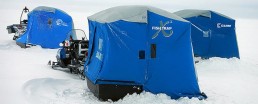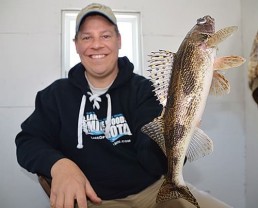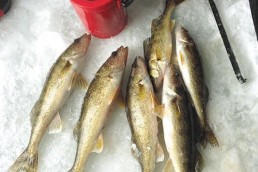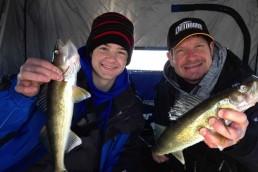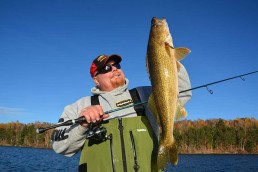Top Ten Midwinter Nuances to Ice More Walleyes
SHARE THIS POST
It seems like as the winter has a firm grip on the Midwest and ice conditions thicken, the walleyes become a bit less aggressive. Watching a red mark on your Vexilar stop in for a visit but not accept your offerings can be a common occurrence. However, there are some nuances an ice angler can take advantage of to turn those lookers into biters.
1. Downsize
When the fish get a bit sluggish, downsize your presentation. When it comes to jigging, this means choosing a smaller jigging spoon and tip it with a smaller piece of minnow. Instead of a minnow head, when going smaller I like to use a small piece of the tail section. Hooking one of the treble hooks right in the middle of the flesh just in front of the actual tail of the minnow keeps the bait on nicely and gives good action. This slight adjustment to the size of your offering often will make the difference between the weight at the end of your rod vs. another looker.
2. Get aggressive
As opposite as it might seem, sometimes during a sluggish time, walleyes will react to certain presentations much like they might react to a crankbait in the open-water months. It’s called the “reaction bite.” My go-to is a vibrating blade lure, such as a Cicada. I sometimes will tip it with a very small piece of minnow tail. This piece is streamlined and doesn’t alter the vibration of the lure, but seems to catch more fish. I add the small piece of tail to the back hook of the front treble. Sometimes the fish come in out of nowhere on your electronics and it’s just a matter of putting your offering in front of them because they are hot and are going to eat. In other cases, they come in slow, and by ripping the lure up and dropping it in front of them and holding it in the strike zone, they will eat.
3. Finesse your deadstick
To me, this might mean going from a walleye-sized ice jig and live minnow to a plain hook and just barely hooking the minnow. I might also downsize the minnow from a large shiner or fathead to a smaller offering, maybe even a crappie minnow. This smaller offering on some days will entice a few more fish.
4. Alter your bait
On a recent Lake of the Woods outing with a fishing partner with very thick ice and cold temps, we were seeing fish on the bottom from time to time with no eaters. That bottom red line of the electronics gets just a bit thicker and then goes to normal size again. We knew there were fish hugging the mud, but they just weren’t going. He had already downsized to a very small spoon and a minnow head. After a while, he pulled out some freeze-dried waxworms he had in his rod bag for a couple of years. He bought them on clearance and really had them as a backup. The moment he added a waxworm to his spoon, he started plucking nice walleyes and saugers from the bottom. Since then, I will add waxworms to my arsenal on occasion, and I have pulled fish I believe otherwise would have only been lookers.
5. Turn off the rattle
You might have heard one definition of insanity—to do the same “things” over and over, expecting different results. Lake of the Woods often has a fun morning/evening bite in that 15- to 20-feet range of water each day. Not every fish in the system takes part, as plenty stay deep, but enough do, which can be advantageous if you hit it right. During an evening bite in about 15 feet of water, we were using rattle spoons. Some fish came in, but quickly left. I switched up to a plain jigging spoon with no rattle or flappers and proceeded to coax some walleyes into biting. This isn’t always the case, as I catch plenty of fish in the shallows on spoons that make noise. But on this occasion, changing up the volume to entice more walleyes was the ticket.
6. Tease them up
When a walleye comes in and looks at your offering, there are a number of techniques that really need to kick in immediately—like second nature—to catch the fish in the event it doesn’t hit right away. One of those techniques is teasing them up. Start jigging and shaking your offering while you raise it up in the water column. When the fish begins to chase, don’t stop. Keep your arms and hands low and use your reel to raise your bait so when that fish flies up and inhales your offering, you have enough arms left to set the hook.
Are you enjoying this post?
You can be among the first to get the latest info on where to go, what to use and how to use it!
7. Raise up your deadstick bait
On Lake of the Woods, the normal deadstick set is about 6 inches off of the bottom. This works well often, as fish tend to hug the bottom. On occasion, have at least one live minnow set up off of the bottom about 2 feet. It seems walleyes and saugers are used to feeding up when chasing minnows. It also appears at times that a live minnow up in the water column intrigues the fish more so than a minnow right in front of their nose. Experiment, but if the fish are not cooperating, try raising up your live bait on your deadstick.
8. Use electronics
If you do not use electronics while ice fishing, you are really missing out. Not only are they effective, but also fun to watch. Electronics tell you if there are fish, where the fish are in the water column and how they are reacting to your presentation. Without them, you are blind. They will catch you more fish and will raise the fun factor of your ice fishing trip.
9. High flyers
One of the many advantages of having electronics is spotting fish high in the water column. It is well known on Lake of the Woods that nice walleyes will come through suspended. When a fish appears suspended, reel up quickly to about 2 feet below the fish and then slowly bring the lure just above it. My experience is if you reel up too fast right to the fish, it spooks them. Once the lure is positioned in front of the fish or ideally just above it, shake it and let it sit still in the fish’s strike zone. If no reaction, start altering your jigging motion until the fish eats. Often, these fish are high in the water column as they are feeding on suspended baitfish and will happily engulf your offering.
10. Move to the fish
When fish get sluggish, they don’t typically move around as much. If you are not on good fish or have plucked a few and can be mobile, shift your location. Sometimes it seems you can pluck a few active fish and really have to work at the others. On Lake of the Woods, this might mean shifting your location on the ice road or use the snowmobile trails (if safe) across the lake and find structure that doesn’t receive much attention. The extra effort can pay off big.
During the dead of winter, choosing a lake that has a good population of walleyes can help your success. In larger lakes, the oxygen content doesn’t drop much and can be a positive with more active fish. If there are saugers in the mix, this is only a bonus, as they simply give you more opportunities to catch fish and work on your walleye fishing techniques.
Midwinter walleyes can be a bit more temperamental, but not impossible by any stretch. By thinking outside of the box and adding some subtle nuances to your ice fishing tool belt, you will find your midwinter walleye fishing trips to be more successful.
MWO
SHARE THIS POST
Did you enjoy this post?
You can be among the first to get the latest info on where to go, what to use and how to use it!
Joe Henry
Tournament angler and licensed charter captain Joe Henry fishes and hunts the Midwest. Henry is a media member of AGLOW and writes for numerous publications, creates videos, appears on a variety of outdoor TV and radio shows and is a frequent seminar speaker. Henry is the Executive Director of Lake of the Woods Tourism.
